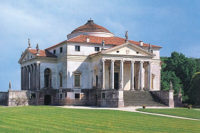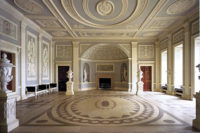Plaster During the Federal and Beaux Arts












The founding fathers of the United States lived and were educated during an era later known as the Age of Enlightenment. It was a period espousing values such as reason, individual merit and greater liberty in philosophical inquiry as legitimate bases for authority. A measure of that inquiry harkened back to the days of Classical Greece, an age of prosperity and high culture. The democratic city-state of Athens harbored schools of philosophy, led by the great minds of men such as Plato and Aristotle. Another significant influence was the ancient Republic of Rome. Its representative form of government was to largely serve as a referential blueprint for the political structure of the emerging nation.
A Federal Style
Perhaps no other single figure embodied the ideals and values of the new American Republic as that of Thomas Jefferson. A gentleman architect himself, Jefferson would lead the way in establishing a national style of civic architecture for the now federated states of the former British colonies. Jefferson held the works of Palladio in particular high esteem, seeing them as of direct lineage from the Roman Republic. Political connotations were thus to be embedded in Federal architecture. Likewise, symbolic meaning was an important component in conveying values, and plaster was an excelling medium of expression in architecture. For example, in 1782 the bald eagle was chosen as the preeminent emblem of the new republic. The eagle symbolized qualities such as long life and majesty; however, its ability to soar above conveyed the most treasured value of liberty. Jefferson’s own commission of a modeled plaster eagle at Monticello in 1812 featured 18 plaster stars, coinciding with Louisiana’s admission as the 18th state.
Close colleagues of Jefferson were the “Father of American Architecture,” Benjamin Latrobe and Charles Bulfinch, widely considered the first native born American, born to practice architecture professionally. Latrobe initially designed the Supreme Court chamber of the Capitol with its domical, ribbed plaster vaulting, whereas Bulfinch led its restoration and elaboration after damage suffered to the Capitol building during the War of 1812. Commissioned to Carlos Franzoni in 1817 was the plaster relief sculpture, Justice. Rich in iconographical meaning, Justice—the most important of the four cardinal virtues—is personified in the figure of a classical maiden. Her scales represent impartiality, her sword signifies her authority. The owl at her side represents the very embodiment of Minerva, Roman goddess of wisdom, whilst to the right, the eagle is a symbol of the republic surmounting the books of law. To the left a winged “genius” presides over the Constitution under a sunburst halo symbolic of truth.
One of the greatest civic spaces ever conceived and a national treasure is the Capitol Rotunda. The cupola was designed by architect Thomas U. Walker, and was completed in 1863 with all of the coffers and ornamentation being realized in plaster. The crowning feature filling the oculus is the “Apotheosis of Washington,” added in 1865. This enormous work, 65 feet in diameter, was realized in plaster, painted al fresco by Constantino Brumidi over the course of 11 months. The fresco quite literally represents the deification of George Washington. Ascending with him at either side are the Roman goddesses Victory and Liberty. In turn, he is surrounded by the Roman gods Minerva, Neptune, Mercury, Vulcan and Ceres symbolizing Science, Maritime Power, Commerce, Industry, and Agriculture respectively. Of particular interest is the American goddess Columbia—the personification of both Freedom and War.
L’École des Beaux-Arts
In the 1840s a young American living in Paris, aspiring architect Richard Morris Hunt, was the first American to be admitted to the École des Beaux-Arts. The École was the most prestigious school of art, sculpture and architecture in the world offering a rigorous study extending from Classical Greece, Imperial Rome through the Italian Renaissance and the French Baroque. After the Civil War, Hunt began designing one mansion after another for wealthy industrialists of the burgeoning Gilded Age. His most opulent commissions came from his primary patron, the Vanderbilt family. Hunt was to inspire and soon be followed by scores of architects practicing in the U.S.: the firms of Carrère and Hastings, as well as McKim, Mead & White provide prominent examples. Lavish ornamentation was characteristic of Beaux Arts architecture and plaster was routinely specified.
Foreign architects were also active in the U.S. Beaux Arts trained French architect Ernest Sanson, and was engaged for two prominent American commissions: the Perry Belmont Mansion in D.C. and notably the Carolands Chateau, south of San Francisco. The Carolands is immense with an inner volume of more than one million cubic feet. Both properties introduced to the U.S. the French plaster tradition of Stuc Pierre, an integrated colored and aggregated gypsum lime plaster in emulation of limestone.
Looking for a reprint of this article?
From high-res PDFs to custom plaques, order your copy today!
















